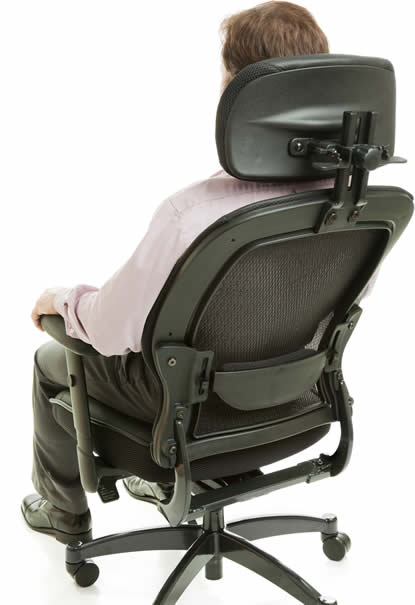Maybe you’ve heard the word “ergonomics” but don’t really know what it means. It is the study of the workplace as it relates to the person working in it. Ergonomics involves designing and developing equipment, room layout, and strategies in a work environment to best protect the human body. The goal is to minimize discomfort, injury, fatigue and stress.
So what does ergonomics have to do with back and neck pain? Discomfort in these two areas of the body are the most common work-related physical complaints. Often caused by ordinary work activities like sitting in a chair or lifting boxes, back and neck pain can be alleviated by applying ergonomic principles on the job.
Chair
Office work usually involves sitting in a chair for extended periods of time. Because this position stresses the spine, it’s important to have an office chair that promotes good posture and supports the back. No single chair is always the best for everyone; the individual must select a chair that suits their specific needs. Some qualities to look for when selecting an office chair are:
- Seat height should be adjustable so that the user’s feet touch the floor in a flat position, arms are even with the desk, and thighs are horizontal to the floor. A seat height between 16 to 21 inches from the floor is usually correct.
- Seat width and depth should support the user comfortably, and the seat should have the ability to be tilted forward or backward.
- Seat material on both the seat and chair back should be padded for comfort. Cloth fabrics tend to breathe more than harder materials.
- Backrest should be 12 to 19 inches wide, supporting the spine fully. If it is a separate piece from the seat, make sure the backrest is adjustable in angle and height. If the entire chair is one piece, look for a backrest that adjusts and then locks into the position you desire.
- Lumbar support, which focuses on the lower back, is key to avoiding back pain. A good ergonomic chair allows for adjustment to obtain the proper position that supports the inward curve of the lower back. If the chair doesn’t have adequate lumbar support, portable lumbar supports are available to place in the chair.
- Swivel features allow the user to rotate the chair without straining to reach areas of the desk.
- Armrests should be adjustable so that arms can rest comfortably and shoulders can be relaxed. The forearm should not be on the armrest when typing on a keyboard.
Computer monitor
The correct monitor height and position helps prevent back and neck problems. Consider these tips:
- Select the monitor height based on the area of the screen you view most frequently. Sit correctly in your chair with your spine straight and head comfortably centered, and position the monitor so that it sits in the spot where your eyes naturally focus on it. Never place the monitor at an angle to the left or right, making you twist to view the screen.
- Consider the monitor size and resolution when choosing the best distance from your eyes to the screen. Place a 17-inch monitor no less than 20 inches away from your eyes, and closer for smaller monitors and farther for larger monitors.
- Remember the lighting of the room when positioning your monitor, minimizing the effects of glare on your screen when you’re working.
- Alter the monitor’s brightness and resolution as needed to prevent eyestrain.
Telephone
If you spend lots of time on the phone, locate it near your primary working area so you don’t have to twist or reach to access it. If you are in a private area, use the speaker phone feature to avoid holding a handset or being tempted to prop it up with your neck. If you can’t use the speaker, purchase a headset that allows you to speak hands-free while maintaining proper posture. Keep writing materials close by so you can take notes without changing your position.
Lifting
If your job requires lifting, make sure you follow guidelines for proper lifting techniques. Keep your back straight and bend at your knees to squat down, instead of bending forward with your back. Always keep the items you’re lifting close to your body to create less stress on your spine. Ask for help when items are heavy.
Breaks
Take short breaks periodically to give your back and neck a change in position and stretch those muscles. Plan to move around every 30 to 40 minutes for best results. Perform basic stretches in your office to give your body a chance to relax and flex the muscles into other positions. Simple torso and neck stretches will go a long way in giving your body the best chance of comfort and health during your workday.
Pain
If you do develop neck or back pain, schedule an appointment with a professional like Dr. Fischer at NYU Langone Medical Center in NYC to identify the source of your pain, and provide treatments to eliminate it. Dr. Fischer can also give you even more suggestions about altering your workplace or your lifestyle to keep your back and neck healthy.

